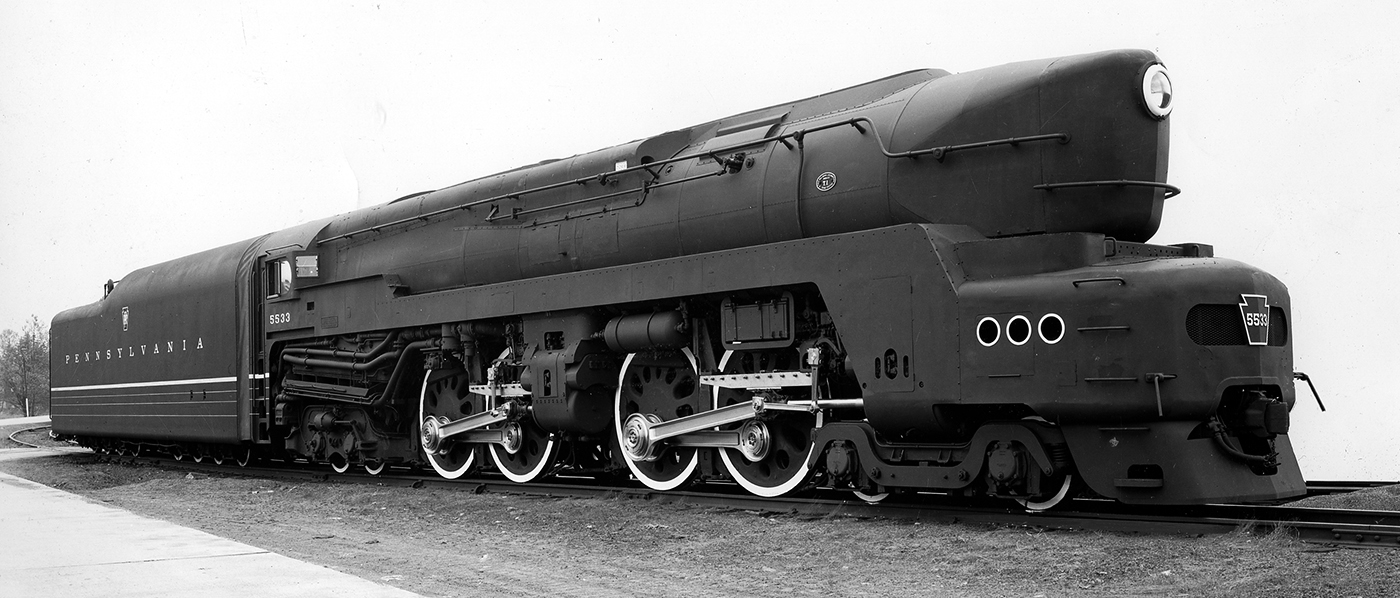Not entirely new, I guess, as they were actually originally built in 1942 (2 prototypes) and and 1945-1946 (50 main productions models) but a new one is currently being built. What is "they"? Well, just one of the craziest, most advanced, fastest steam locomotives to ever ply the U.S. railroads: The Pennsylvania T-1 "duplex"

A small bit of a history lesson, as I'm sure aren't familiar with these things. Headed into the '40s, the Pennsylvania Railroad realized that they hadn't built a new passenger locomotive since the end of the K-series 4-6-2 Pacifics, a series of locomotives that had started in 1914 and ended in '28. Trains were getting longer and heavier and the Pennsy was finding themselves doubling up K4s on the head of their trains, which wasn't efficient or economic.
So the PRR called up Baldwin Locomotive Works, who were kind of the mad scientist of locomotive designs, and gave them a performance bogey and set them loose. This was a radical departure for the time as the PRR was usually conservative in their locomotive designs and was big on building their own locomotives at their Juniata shops.
The result was the T-1 which was based on Baldwin's experimentation with "duplex" locomotives. This designs split the locomotive's driving wheels into two sets, each with its own pair of cylinders and rods. Traditionally, the only locomotives with two sets of drivers were articulated locomotives, but the T-1 used one rigid frame. In a duplex design, cylinders could be smaller and the weight of side and main rods could be drastically reduced. Given that the movement of the main rod could not be fully balanced, the duplex design would reduce "hammer blow" on the track. The lower reciprocating mass meant that higher speeds could be achieved, and there are reports of T-1s operating at over 120mph during passenger service. They were also styled by famed industrial designer Raymond Loewy, making them very distinctive with their sharknose cowling.
Unfortunately, they were plagued with issues. One was that they were so massively powerful, that they were plagued with slippage even once they had a train moving, they just made more power than they could put to the rails effectively. This was also exacerbated by a design issue on the early units which tied the front and rear "engines" together on their suspension and would cause the front wheels to lift on a curve. Slipping the wheels for extended periods also had a tendency to bust up the experimental (And fragile) rotary cam valve gear. A big portion was that engineers were not trained properly for operating them and tried to operate them as a conventional locomotive, and tended to be a bit too "generous" with the throttle. They were also expensive, difficult to maintain and arrived late in the era of steam. Steam locomotive development was winding down and dieselization was starting. So by 1956, the PRR had retired and scrapped every last one of them.
So, where is this going? Well, the T1 Trust, a private organization, has decided that that was a crime against humanity and has started to construct a brand-new, from the ground up, Pennsylvania T1 that will be 100% operational, while fixing some of the original design issues. I originally kind of dismissed it as a bit of a pipe dream, but after reading an interview with Trains these people seem to be going in with realistic expectations ($10 million budget, 2030 completion date) and appear to be pretty well organized. They have already started construction, having built a new number plate and headlight, cast a set of driving wheels and found a surviving rotary cam valve gear setup to document and recreate, as well as working on getting a place to operate it. They also give solid reasons why they aren't restoring an existing locomotive.
I don't expect everyone to get all geeked out by this like I am, but you have to be impressed at the scale of such a project and the logistics of building something that the industry doesn't even exist to do anymore. I don't think any of us are allowed to complain about fixing up a rusty car anymore, in light of this.





























